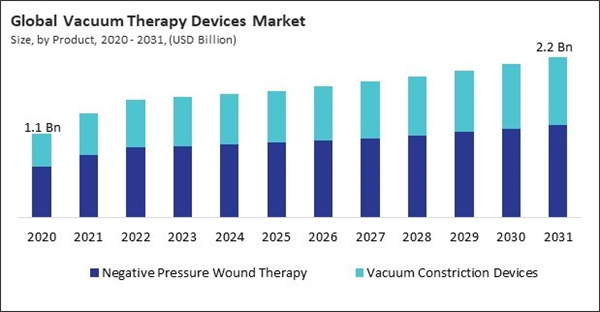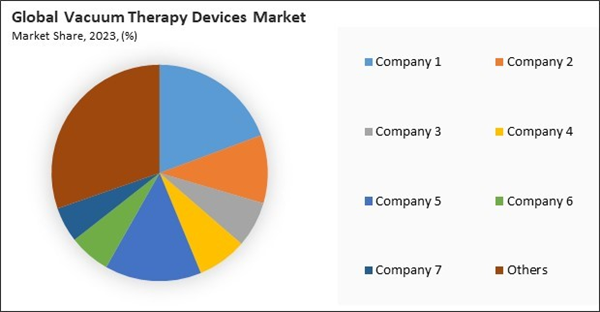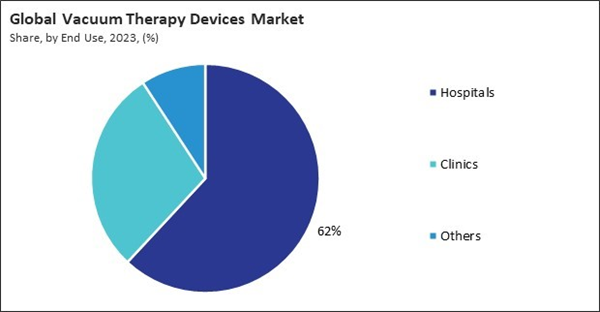The Global Vacuum Therapy Devices Market size is expected to reach $2.2 billion by 2031, rising at a market growth of 3.8% CAGR during the forecast period.
In Japan, the aging population is a primary factor driving the rising demand for vacuum therapy devices. According to the Statistics Bureau of Japan, the population aged 65 years and over was 36.23 million (29.0 percent of the total population) in 2022, making it one of the oldest populations in the world. This demographic trend is leading to an increase in age-related health issues, including chronic wounds such as pressure ulcers and venous leg ulcers, which are prevalent among the elderly. Thus, the Asia Pacific market acquired 25.4% revenue share in the market 2023.
Vacuum therapy devices, which have been shown to be helpful in accelerating wound healing, are anticipated to considerably decrease the global burden of chronic wounds. Hence, the growing need for effective and innovative treatment options is expected to drive the continued expansion of the vacuum therapy devices market in the coming years.
Additionally, patients educated about the benefits of advanced wound care are more likely to seek out these treatments and adhere to prescribed therapy regimens. Thus, this growing awareness among healthcare providers and patients contributes to the widespread adoption of vacuum therapy devices across various healthcare settings.
However, the perceived effectiveness and necessity of surgical options further contribute to the challenge of promoting vacuum therapy devices as a viable alternative, particularly when these devices are seen as supplementary rather than essential. Thus, the availability of alternatives may hamper the growth of the market.
The leading players in the market are competing with diverse innovative offerings to remain competitive in the market. The above illustration shows the percentage of revenue shared by some of the leading companies in the market. The leading players of the market are adopting various strategies in order to cater demand coming from the different industries. The key developmental strategies in the market are Acquisitions, and Partnerships & Collaborations.
In Japan, the aging population is a primary factor driving the rising demand for vacuum therapy devices. According to the Statistics Bureau of Japan, the population aged 65 years and over was 36.23 million (29.0 percent of the total population) in 2022, making it one of the oldest populations in the world. This demographic trend is leading to an increase in age-related health issues, including chronic wounds such as pressure ulcers and venous leg ulcers, which are prevalent among the elderly. Thus, the Asia Pacific market acquired 25.4% revenue share in the market 2023.
Vacuum therapy devices, which have been shown to be helpful in accelerating wound healing, are anticipated to considerably decrease the global burden of chronic wounds. Hence, the growing need for effective and innovative treatment options is expected to drive the continued expansion of the vacuum therapy devices market in the coming years.
Additionally, patients educated about the benefits of advanced wound care are more likely to seek out these treatments and adhere to prescribed therapy regimens. Thus, this growing awareness among healthcare providers and patients contributes to the widespread adoption of vacuum therapy devices across various healthcare settings.
However, the perceived effectiveness and necessity of surgical options further contribute to the challenge of promoting vacuum therapy devices as a viable alternative, particularly when these devices are seen as supplementary rather than essential. Thus, the availability of alternatives may hamper the growth of the market.
The leading players in the market are competing with diverse innovative offerings to remain competitive in the market. The above illustration shows the percentage of revenue shared by some of the leading companies in the market. The leading players of the market are adopting various strategies in order to cater demand coming from the different industries. The key developmental strategies in the market are Acquisitions, and Partnerships & Collaborations.
Driving and Restraining Factors
Drivers
- Rising prevalence of chronic wounds
- Increasing awareness and adoption of advanced wound care
- Growing healthcare expenditure globally
Restraints
- High cost associated with vacuum therapy devices
- Availability of alternative treatment options
Opportunities
- Government support and favorable reimbursement policies
- Expansion of home healthcare segment
Challenges
- Limited awareness and training among healthcare professionals
- Stringent regulatory requirements
Product Outlook
End Use Outlook
On the basis of end use, the market is classified into hospitals, clinics, and others. The hospitals segment acquired 62% revenue share in the market in 2023. This dominant position is largely due to the extensive use of vacuum therapy devices in hospital settings, particularly for managing complex and chronic wounds, post-surgical care, and other critical care applications.Application Outlook
By application, the market is divided into chronic wounds, acute wounds, and erectile dysfunction. The chronic wounds segment witnessed 52% revenue share in the market in 2023. This is primarily attributable to the extensive utilization of vacuum therapy, particularly negative pressure wound therapy (NPWT), in the treatment of chronic wounds.Type Outlook
Regional Outlook
Region-wise, the market is analyzed across North America, Europe, Asia Pacific, and LAMEA. The Europe segment witnessed 30% revenue share in the vacuum therapy devices market in 2023. Increasing rates of diabetes and other comorbidities, as well as the aging populations, have resulted in a high incidence of chronic ulcers in European countries like the United Kingdom, France, and Germany.List of Key Companies Profiled
- 3M Company
- Augusta Medical Systems
- Boston Scientific Corporation
- Cardinal Health, Inc.
- Coloplast Group
- Smith & Nephew plc
- Medela AG
- ConvaTec Inc.
- B.Braun Melsungen AG
Market Report Segmentation
By Product
- Negative Pressure Wound Therapy
- Vacuum Constriction Devices
By End Use
- Hospitals
- Clinics
- Others
By Application
- Chronic wounds
- Acute Wounds
- Erectile Dysfunction
By Type
- Non-Portable Vacuum Therapy Devices
- Portable Vacuum Therapy Devices
By Geography
- North America
- US
- Canada
- Mexico
- Rest of North America
- Europe
- Germany
- UK
- France
- Russia
- Spain
- Italy
- Rest of Europe
- Asia Pacific
- China
- Japan
- India
- South Korea
- Singapore
- Malaysia
- Rest of Asia Pacific
- LAMEA
- Brazil
- Argentina
- UAE
- Saudi Arabia
- South Africa
- Nigeria
- Rest of LAMEA
Table of Contents
Chapter 1. Market Scope & Methodology
Chapter 2. Market at a Glance
Chapter 3. Market Overview
Chapter 4. Competition Analysis - Global
Chapter 5. Global Vacuum Therapy Devices Market by Product
Chapter 6. Global Vacuum Therapy Devices Market by End Use
Chapter 7. Global Vacuum Therapy Devices Market by Application
Chapter 8. Global Vacuum Therapy Devices Market by Type
Chapter 9. Global Vacuum Therapy Devices Market by Region
Chapter 10. Company Profiles
Companies Mentioned
- 3M Company
- Augusta Medical Systems
- Boston Scientific Corporation
- Cardinal Health, Inc.
- Coloplast Group
- Smith & Nephew plc
- Medela AG
- ConvaTec Inc.
- B. Braun Melsungen AG
Methodology

LOADING...











